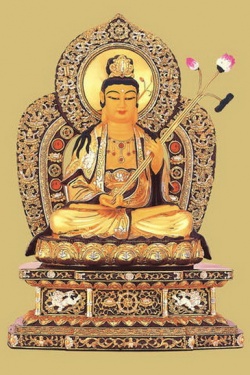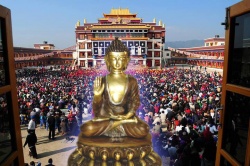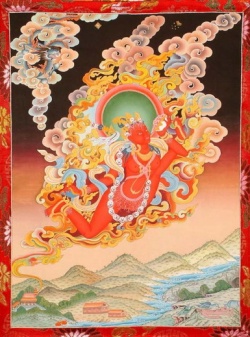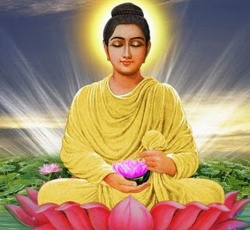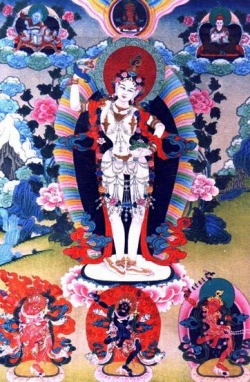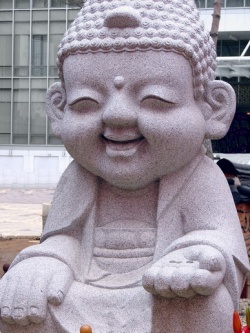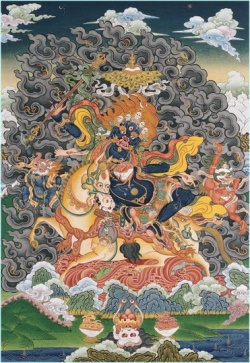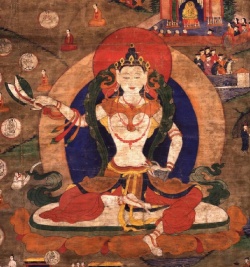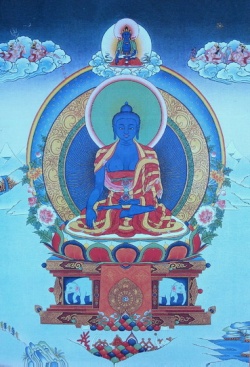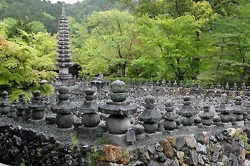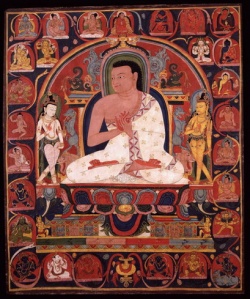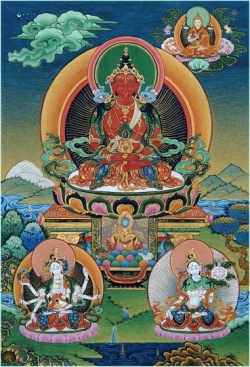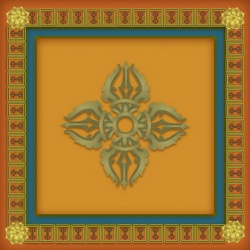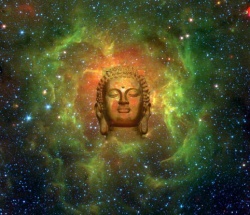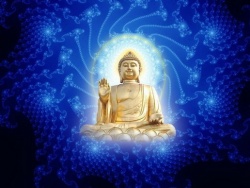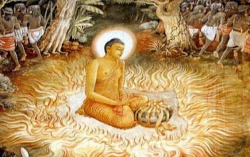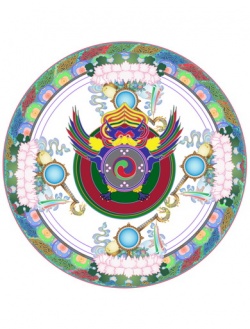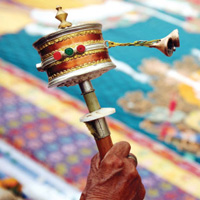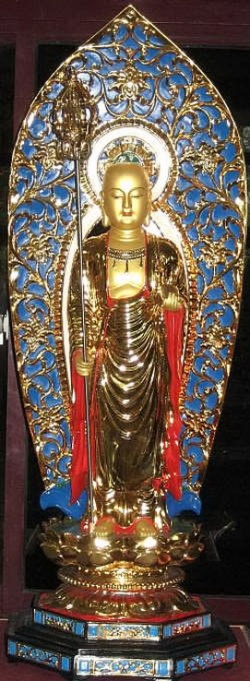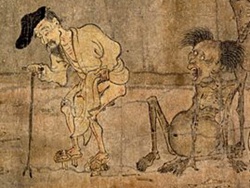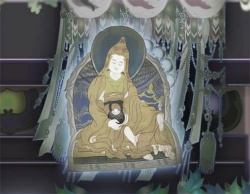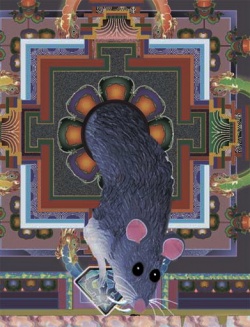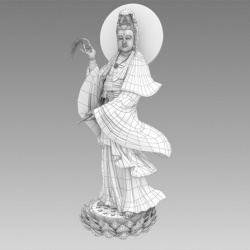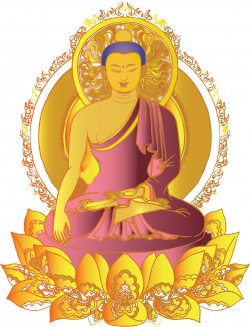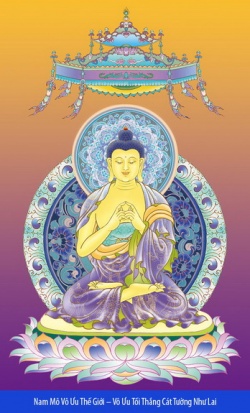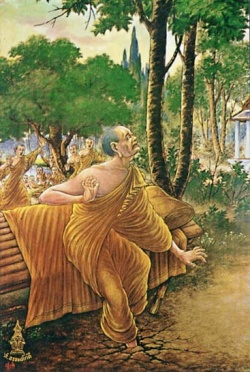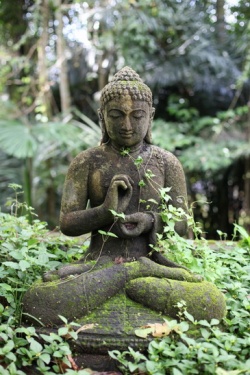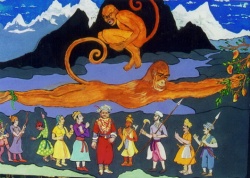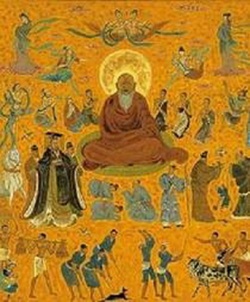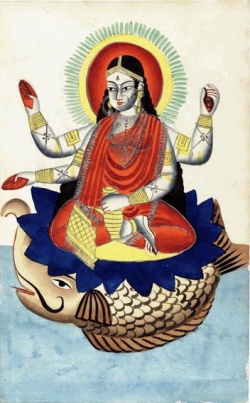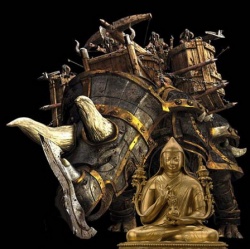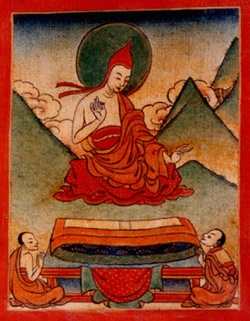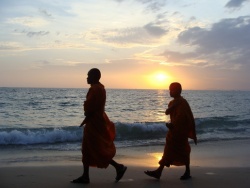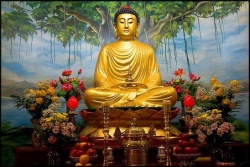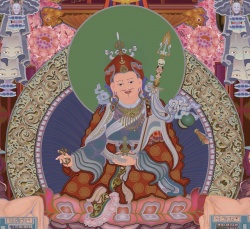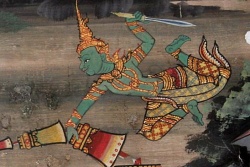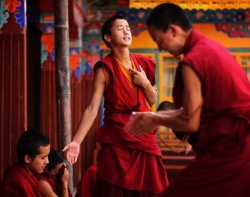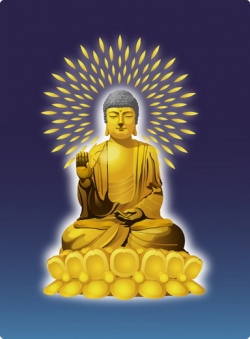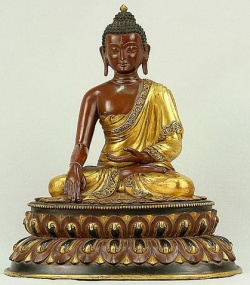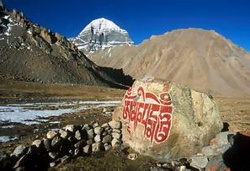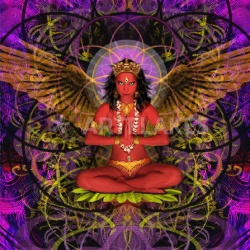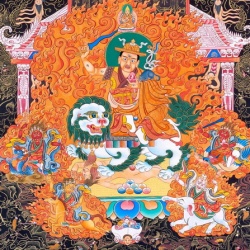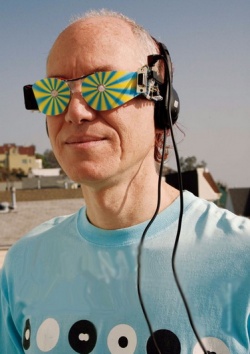Buddhism Basics
More than twenty-five hundred years ago, a man who had been searching for the truth for many, many lifetimes came to a quiet place in northern India and sat down under a tree. He continued to sit under the tree, with immense resolve, and vowed not to get up until he had found the truth.
At dusk, it is said, he conquered all the dark forces of delusion; and early the next morning, as the planet Venus broke in the dawn sky, the man was rewarded for his age-long patience, discipline, and flawless concentration by achieving the final goal of human existence: enlightenment.
At that sacred moment, the earth itself shuddered, as if “drunk with bliss,” and, as the scriptures tell us: “No one anywhere was angry, ill or sad; no one did evil, none was proud; the world became quite quiet, as though it had reached full perfection.” This man became known as Buddha.
Buddha was a human being, like you or me. He never claimed divinity, he merely knew he had the buddha nature, the seed of enlightenment, and that everyone else did too. The buddha nature is simply the birthright of every sentient being, and I always say: “Our buddha nature is as good as any buddha’s buddha nature.”
Albert Einstein on "Buddhism"...
"Buddhism has the characteristics of what would be expected in a cosmic religion for the future: it transcends a personal God, avoids dogmas and theology; it covers both the natural and spiritual, and it is based on a religious sense aspiring from the experience of all things, natural and spiritual, as a meaningful unity" ---- Albert Einstein
Buddhism has been called the science of the mind. Buddha means awake.
"The Buddha was often referred to as the Awakened One. Awakened to all the illusions and freed from them. The analogy that is often used is that the non-enlightened state is like being asleep. This is because your Buddha-nature, your enlightened awareness, is masked by a the sleep of ignorance, greed, and hatred. When you awake to the fact that that all is part of the illusion of egocentricity, you are free from that illusion. So you are awakened from the ego-illusion and all that goes with it." Rob Nairn
CONTENTS
BOOK - The Future of Buddhism
Introduction by Matrine Batchelor
Interview with Dalai Lama
THE THREE BENEFITS IN LEARNING BUDDHISM - Dharma talk by Lian Sheng
Buddha, The Four Noble Truths & The Eightfold path
BUDDHISM - article
Mindfulness, Awareness & Wakefulness - Excerpts from Diamond Mind, By Rob Nairn
Some Common Terms & Insights
More quotes, Law of Karma
Preliminary Practices - Ngondro
Practical Intention to Become Enlightened - The Six Perfections and the Three Trainings of Bodhisattva
A Guide to Approaches to Enlightenment by Tathang Tulku - The Nine Yanas
Lama Zopa soundbites
related reading - books
related articles & links -
Buddhist centres in London
Also, if you are interested in Teachings of the Buddha Buddhism be sure to check out our related pages:
Main Buddhist Articles Index , Diary Events , Buddhist Articles ,Buddhist Quotes page, Buddhist Masters, Buddhist Centres , Buddhist Practices , Buddhist Peace Prayers
, Enlightenment,Bodhicitta , Zen , Dzogchen , Nyingma , Rainbow Light Body , Reincarnation,Karma , meditation , Mindfulness , Taking refuge ,Emptiness , 6 root delusions , Mind , Tibetan Medicine , Attachment , Suffering
THE FUTURE OF BUDDHISM
By Sogyal Rinpoche
Bestselling author of The Tibetan Book of Living and Dying
Publication: 4th April 2002, Rider £7.99
Best-selling author and revered spiritual teacher, Sogyal Rinpoche treats us once again to a journey of true enlightenment, with this, his latest book The Future of Buddhism. Following the extraordinary success of The Tibetan Book of Living and Dying, Soygal Rinpoche has emerged as one of the most respected and successful spiritual teachers of modern time. Drawing on 25 years of experience of teaching in the West, this book is a fascinating collection of articles, which are reflections of some of the most vital issues affecting Buddhism in the modern world.
Presented in a clear and accessible manner, these articles address a selection of crucial issues, specifically highlighting areas such as, adaptation, training, integration and the support of a sangha (a community of practitioners), as well as how to ensure that Buddhism is made wholly accessible while still retaining its uniqueness and great strength as a complete spiritual path.
Also discussed, is the contribution which has been made to the modern world by the spiritual and mental dimensions of healing within the Buddhist tradition. Focusing on areas such as, training the mind and meditation, the author elaborates on the effects of the mind on our spiritual, mental and physical well-being. Finally and perhaps most profoundly, Rinpoche discusses the deceptions which can be cast by our own minds and the importance of being able to permeate the mind and its delusions, so as not to be dominated by ignorance and misunderstanding. The Future of Buddhism is a true gem, a blue print for our time. Its accessible manner will appeal to both practising Buddhists and the general reader.
THE AUTHOR
Sogyal Rinpoche was born in Tibet and entered a monastery when he was four months old. He fled the country with the Dalai Lama in 1959 and was educated in India and Cambridge. Since then, he has taught throughout the world. He is the spiritual director of Rigpa, an organisation devoted to introducing the teachings of the Buddha and to offering advice on spiritual care for the dying.
INTRODUCTION
"In general the teaching of the Buddha is very vast and profound, it is not so simple as to grasp it in one time. If we had to summarise the complete teaching of Buddha we would see that all is included in two main points, that is:
cause no harm to any sentient beings,
always try to benefit all sentient beings;
or, if we are not able to benefit others we should at least avoid all harmful thoughts and actions.
Buddha Himself summarised in a few lines the essence of His teachings: abandon all harming actions and all negative actions, practice all positive actions completely and control your own mind. This is the teaching of Buddha. "
His Holiness Trijang Dorje Chang.
There are many different types of Buddhism: Theravada Buddhism of South - East Asia, Zen Buddhism of the Far East, Tibetan Buddhism - Mahayana, Hinayana & Vajrayana
Each has been influenced by the culture in which it developed. The robes, chants and practices are different, but they all share the basic teachings of Buddha.
All Buddhists believe the Buddha awakened to the nature of life and his potential for wisdom and compassion. He overcame the three poisons of hatred, greed and dillusion, and saw the root of suffering - craving.
The way to extinguish it is through cultivating the three teachings of ethics, meditation and wisdom.
The different types of Buddhist meditation consist of two simple, timeless qualities: concentration and inquiry (insight). Concentration helps you develop stillness and calmness of mind. Inquiry cultivates a certain brightness of mind, or clarity (insight - mindfulness). Both qualities together enable you to deepen your awareness until it becomes creative - which in turn will help you respond to life in a wiser, more compassionate way.
Though Buddhism is rooted in spiritualism, it also encompasses the material world. It offers a way of life based on respect for people, animals and the environment that can be practised from Burma to Brixton.
Matrine Batchelor
Interview with Dalai Lama, by Robert Thurman - May 2001
R.T. Now for a really simple question: What is the essence of Buddhism?
Respect all forms of life, and then compassion and affection toward all sentient beings, with the understanding that everything is interdependent - so my happiness and suffering, my well-being, very much have to do with others'.
R.T. - What prevents people from understanding this?
When people think it's all about doing tantric visualizations and rituals.
When I talk about the Buddhist dharma, I'm not talking about just chanting and rituals. If it's thought to be a philosophy, it's not that, either. The dharma, it's just the mind. I'm afraid that among the Tibetans, the Chinese and also some Westerners - the new Buddhists - in many cases they consider the practice of Buddhism is simply to recite something and perform some ritual, putting false expectations on the esoteric magic of tantra: "Oh, if I do this, I may get something amazing!" So they neglect the basic instruments that actually transform our mind. These instruments are the altruistic spirit of enlightenment (bodhichitta), the transcendent attitude, renunciation, the realization of impermanence, the wisdom of selflessness. People who think they have a magic gimmick neglect these things. So their inner world, their inner reality, remains very raw.
Sadly, use of ritual can feed that neglect. Knowledge of philosophy can also feed that. It's a great tragedy. If Buddha came here, if Nagarjuna [a great Indian Buddhist philosopher, circa the second century C.E.] came here, I think they would feel very critical about this; they would give us a big scolding. Nagarjuna would say that all our complex philosophies are not meant just for academics, our elegant rituals are not just for theatrics.
What about those who think Buddhism is simply an unfair rejection of the world? Even today, the pope thinks Buddhism is too depressing and negative.
Most importantly, those people who consider themselves Buddhists must practice the Buddha's dharma sincerely - that will be the proof of the value of Buddhism. Some Tibetans today also say that in the past, the way of life was that the dharma almost served as a livelihood or a routine profession. The Buddhist was not thinking of nirvana, not caring for liberation, just how to make a living. Officials used it for their lives, monks, nuns and lamas for their lives. Inside, in their inner world, they were like ordinary people, lusting and hating. So the dharma became a poison in this way.
When there is too much focus on the Buddhist institution, and the country goes to waste, that's what it means when people say Buddhism ruined the country. According to that reality, these accusations become true.
Therefore, the best answer for this criticism is for ourselves to practice sincerely. We can aim for nirvana and Buddhahood. But in the meantime, we can be practical, develop the education field and improve the worldly life in various ways to benefit society and humanity. In this way, we can be fully engaged.
Are there particular dharma teachings that are especially useful for people at different ages -for example, for younger people filled with turbulent emotions or for older people worrying about death?
I don't think so. Buddha dharma is dealing with emotions. Young and old, the emotional world is the same. Some feelings closely associated with the physical body may differ in emphasis.
Then would you say that young persons benefit from meditating about death as much as older persons do?
Yes, in general. However, just to think about death alone, don't know how useful it is. For a materialist who doesn't believe in future life, meditating on death might develop a bit more contentment, but it won't bring great benefit. In Buddhism, meditation on death is important in the context of the matter-of-fact expectation of limitless lives and the sense or the possibility to transform our mind while evolving through those lives. The time of this life with liberty and opportunity becomes very important, actually the most precious time; wasting such a lifetime is a great tragedy. So we concentrate and meditate on death and impermanence until we powerfully feel that our precious lives with liberty and opportunity might get wasted if we don't practice. In this case, since through ultimate wisdom yor can attain ultimate freedom and ever, the exalted state or Buddhahood, you are energized by meditating on impermanence and death. Otherwise, just to do it in a materialist context might just make someone feel demoralized. That would be wrong, don't you think? What do you think about the relationship of religion and politics?
The Rolling Stone interview: The Dalai Lama (Rolling Stone) New York May 24, 2001 Author: Robert Thurman . Full Article - http://www.tibet.ca/wtnarchive/2001/5/8_1.html
THE THREE BENEFITS IN LEARNING BUDDHISM
Dharma talk on 3/11/92 (page 265-266 Achievement of Rainbow Light Body volume five) Translated by Yuan Zheng Tang
"What is the purpose of learning Buddhism ?" This is a favorite question posed to many Buddhists. From a Tantrayana point of view, one can attain three great benefits by learning Buddhism:
The first is "One can be enlightened as a Buddha in one's life ."
The second is "One can obtain a siddhi - (Pureland).
The third is "The capability of helping others eradicate calamities, accumulate merit, generate loving-kindness and subdue evil force."
If you are asked : "What is your objective of learning Buddhism ?" You may answer as such : "For the purpose of being enlightened as a Buddha and to be reborn in a Pureland. I can carry also out rituals to help others!"
Although some may go even further to ask you :
"Why do you want to be enlightened as a Buddha ? Why do you want to be born in a Pure-land ? Why do you want to have power generated by dharma ?"
These three benefits will lead you very far.
Once you are enlightened as a Buddha - You are free from any anxiety, as you have full self-mastery of yourself.
Born in a Buddha Land, you will always enjoy bathing in rays of brilliance and happiness.
If you have dharma prowess , your wishes will always be fulfilled.
By learning Buddhism, you are taking steps towards self-mastery, freedom from anxiety, brilliance in your body and mind, purification in your body, speech and mind , and the enjoyment of runs of good luck.
Are these attributes not widely sought after by our fellow human beings ? Put in some deep thought and we can find a perfect answer to these questions!
Of course, there are those who like to hold a heretical view: "Why must I be a Buddha ? I prefer to live in this world." "I dislike this Samsara world, maybe I will enjoy more in the nether world !"
"To me, a dog may lead a better life than a human being."
Learning Buddhism has the following benefits:
One can
1. can be enlightened in a single life.
2. be free from any form of anxiety.
3. have self-mastery.
4. bathe in rays of brilliance and happiness.
5. enjoy runs of good luck.
If you have all these benefits, your life will be most perfect. - This is the most perfect answer. Having to reside in hell or be born as a dog will not be as perfect, as we would be unable to control our lives and sometimes our lives can be very miserable. This is where the crux of the problem is.
Om Mani Padme Hum
http://www.tbsn.org/english/ True Buddha Teaching Site, Lots of info, & loads of useful teachings
Buddha, The Four Noble Truths & The Eightfold path
Gautama Siddhartha, the Sakyamuni Buddha, was born in 620 BCE in India on the Nepal side. He ascended in 543 BCE.
The Buddha sought a way to free people from suffering pain and reincarnation.
The Sermon at Benares is the Buddha's equivalent of 'Jesus' sermon on the Mount. In it the gist of Buddhist teaching is given. The "Four Noble Truths" that are contained in this document.
"Existence is unhappiness" / "unsatisfactoriness" - suffering
"Un-happiness is caused by selfish craving"
"Selfish Craving can be destroyed"
The eight-fold path is the fourth truth, by which this can happen. The Path's steps are:
right understanding
right purpose or aspiration
right speech
right conduct
right vocation
right effort
right alertness
right concentration
In his Enlightenment, Gautama Siddhartha was shown that pain and suffering is caused by attachment to the process of living and other people. The cravings of life can never be satisfied. this attachment results in frustration and negative action that generate karma. Life creates karma which makes the necessity for further lifetime, as karma is both made and cleared while in the body.
BUDDHISM ROOTS
Buddhism is the beliefs of Gautama Buddha which arose as a clarification and reform movement of Hinduism
In many ways the objectives of Buddhism are the same as those of Vedanta and Yoga. Gautama Buddha avoided, however, giving even the barest name to that which is ultimately real, both in its universal aspect as Brahman and in Its human aspect as the deepest self, or Atman. He felt that such terms were too easily turned into ideas and forms of thought that would detract from direct experience. His teaching was that people suffer because of avidya or Ignorance, of the total relativity of the world of things and events. Thought is qvidya. because it is a process of Ignoring; that is, It cannot focus on any one aspect of experience without ignoring everything else. it Is a way of looking at life bit by bit Instead of totally and leads in turn to grasping (trishna, in Buddhism), or trying to wrest the desirable bits of experience away from the whole; however, because the good Is always relative to the bad, this separation can never be accomplished. Similarly, one can never experience a solid without a surrounding space, space and solid being relative to each other. Giving up grasping leads to the Buddhist ideal of Nirvana which Gautama Buddha refused to define except in negative terms, as the Vedantist defines liberation.
Gautama Buddha's teaching led to a misunderstanding to which Vedanta is likewise prone, namely, that liberation may be sought as an escape from suffering, or as a permanent state of bliss. Later Buddhist leaders, especially those of the Mahayana school, corrected this misunderstanding by pointing out that seeking Nirvana as an escape was still grasping. Thus, their Ideal of the wise individual went beyond the older Hindu view of leaving the world, that is, the social world, to prepare for death. it comprised returning into the full activity of society once liberated so that, free from fear, one could devote oneself to acts of compassion for those still In the bondage of mavq,, Buddhist teaching urges, however, morality and compassion not as a commandment but as voluntary action to which the free person commits himself or herself without hope of reward or fear of punishment. No thought Is found in Buddhism of moral conduct as conformity to a divine pattern, for it considers moral standards like rules of grammar, that is, human conventions necessary for social existence but without any absolute authority.
Although Buddha gave no name to what he considered ultimate reality, later Buddhist teachers spoke of the true state of the world as sunyata, or 'emptiness,' meaning more exactly, 'empty of any definable characteristic' or unclassifiable.' This philosophical attitude is in no sense equivalent to Western atheism or nihilism, for what is empty is not reality itself but every idea in which the human mind attempts to grasp.
http://www.ivybridge.devon.sch.uk/departments/re/buddism.html
read also page on emptiness
Mindfulness, Awareness & Wakefulness
Excerpts from Diamond Mind, By Rob Nairn
p27
Mindfulness is the systematic training in knowing what is happening, while it is happening. So if I'm standing here waving my right arm around I'm mindful, I know I am doing it. If I'm not mindful, only you know I'm doing it. Mindfulness is this moment-to-moment precision about your consciousness in relation to your body, mind, and environment.....
p28..
Awareness is a quality of knowing which develops out of that, encompassing of whatever is happening around you without directing attention specifically to it. if I become mindful, I become more aware of things both within and without. So awareness develops out of mindfulness.
Wakefulness is a term that is used in a number of different contexts. In Buddhism, the term of wakefulness is applied to that quality of mind which is no longer lost in not wanting to know. It is a quality of mind that is spontaneously present and alert and therefore picking up what's going on. So it is a sharpening of awareness. It is also applied to somebody who has woken to the true nature of his or her own mind in which case it has a much more extended meaning. That means that you are beginning to move into the area where you are enlightened.
The Buddha was often referred to as the Awakened One. Awakened to all the illusions and freed from them. The analogy that is often used is that the non-enlightened state is like being asleep. This is because your Buddha-nature, your enlightened awareness, is masked by a the sleep of ignorance, greed, and hatred. When you awake to the fact that that all is part of the illusion of egocentricity, you are free from that illusion. So you are awakened from the ego-illusion and all that goes with it.
These three terms are useful to look at because they describe the different stages we experience. It's quite useful to see meditation as a growth process, rather than a mystical or magical experience. As a growth process, it has its own systematic order. It's graduated.
..............
pp104 -105
Writers have tried to describe enlightenment. Usually it is described in terms of the qualities that arise in the mind and of the states that fall away. This is the best we can do.
Enlightenment is when all the inherent enlightened qualities manifest and when all the obscurations which prevent our experience of them fall away. So it is not a goal we can strive for. The very act of striving will keep us trapped within the cycle of thinking.
Enlightenment is already there - like a diamond buried in the mud. It is not something we have to go and find an bring home. It is already there. Which is why, in our meditation, in the very beginning, we train ourselves in knowing that we have nothing to strive for. Nowhere to go, nothing new to create. It's all here already. The path of training is simply systematically to remove the obstacles. To free ourselves from the mind poisons. The route to that, inevitably, is mindfulness.
In some schools of Buddhism it is said that enlightenment is not possible except in the time of the Buddha. To me (Rob Nairn), that is a misunderstanding of the Buddha's teaching. Others say enlightenment is not possible now because we are in a dark age. It seems to me that is also a misunderstanding and a perversion of the Buddha's teaching. Nowhere have I read the Buddha saying that that is the case.
If you look at Buddhism within the context of Vajrayana, Tibetan Buddhism, Lamas are quite unequivocal: "Enlightenment is possible in a lifetime." If we really look at that statement, it frees us from the ambitious mentality that say's "I must accumulate credentials." What it is pointing to is that the human mind can, at any moment, experience enlightenment once it has truly understood letting go.
Excerpt from Diamond Mind, A Psychology of Meditation by Rob Nairn - Highly Recommended along with Mindfulness, In Plain English - for serious meditators
read more: mindfulness, no-thought
Some Common Terms & Insights
Ignorance
Buddha recognized that ignorance of our true nature is the root of all the torment of samsara, and the root of ignorance itself is the mind’s habitual tendency to distraction.
To end the mind’s distraction would be to end samsara itself; the key to this, he realized, is to bring the mind home to its true nature, through the practice of meditation.
There could be no bigger mistake than to think that ignorance is somehow dumb and stupid, or passive and lacking in intelligence. On the contrary, it is shrewd and cunning, versatile and ingenious in the games of deception, and in our wrong views and their burning convictions we find one of its deepest and, as Buddha said, most dangerous manifestations:
What do you have to fear from the wild elephant
Who can only damage your body here and now,
When falling under the influence of misguided people and wrong views
Not only destroys the merit you have accumulated in the past,
But also blocks your path to freedom in the future?
Suchness (tathata)- & Sunyata - Emptiness / no-thingness
It's like this now - According to Nagarjuna, Sunyata is not nothingness, but it is truth or absolute reality of things or suchness (tathata) of the universe.
See reality as it is right now - with no fear or desire attached. Ultimately this moment is as it is now. Now is perfect - as it's meant to be. Enjoy the present moment, smell the flowers, use all your senses (but don't be a slave of them)
Impermanence
Everything in this world is subject to change. No-thing has any independent permanent quality.
Be very wary of saying 'I am always like this'. One's personality is not always the same - it can change over time or in different situations. Look at seasons, Yin / Yang, day/ night etc.
Interdependence
Everything is interdependent. We are all linked. Dependent Arising - Everthing phenomenal is dependent on causes and conditions.
Prajna is not merely intellectual intuition or a non-dual wisdom but freedom as well.
Karma
Law of cause and effect see below
"The Tathagata is a personal manifestation, the individualisation of the absolute or sunyata or prajna in Mahayana Buddhism, likewise individual soul or atman in Vedanta philosophy. As this is a free phenomenalisation, there is no conceivable limit to the number, form and occasion of these manifestations. All beings have also the Buddha nature. Gotama Buddha is not the only instance of man attaining perfection. This is why the Mahayana Buddhism is exemplified the Triple body of the Buddha (Trikaya). Thus, the dual nature of the Buddha, as one with the Absolute (Sunyata) and the other actively pursuing the welfare of beings, supplies the philosophical basis for conception of Trikaya theory in Mahayana Buddhism."
"The three bodies of Buddha are:-
Dhammakaya- the cosmical body is his essential nature: it is the one with the Absolute; Sambhogakaya- the body of bliss and Nirmanakaya- Assumed body. As the Dhammakaya, Buddha fully realises his identity with the Absolute (dhammata or sunyata) and unity (samata) with all beings. "
Mindfulness
(also see above)
Do everything with mindfulness - be fully present in the moment.
Be aware of - thoughts, emotions, space, silence, stillness, gaps, in the present moment - moment to moment
see pages on: Mindfulness, Meditation & Awareness
Dalai Lama
Dalai is Mongolian for "ocean",
Lama is Tibetan for "spiritual teacher,"
hence Dalai Lama
Boddhisattva
In the earlier Buddhism the name for noble human beings, that let themselves be born again and again to save all living beings from suffering, renouncing self to be released from rebirth.
Geshe
Geshes are usually Tibetan monks (but we have few examples of western Geshes) who have acquired a great knowledge in Buddhist philosophy and passed severe examinations in front of hundreds of other monks and Lamas. This training entitles them to become perfect teachers of Dharma. To teach Dharma is the supreme generosity, since it leads us towards the perfect and ultimate happiness and freedom.
Tulku
Tulkus, the Tibetan word for reincarnated Lamas, are the great richness of Tibetan Buddhism. As Lama Gangchen says: "In the world people have many qualities acquired through learning but there are others who are born with these qualities. In Tibetan Buddhism the persons with these inborn qualities are researched all over and when found they are highly revered". Tulkus are highly realised beings that have control over their birth and that choose to take rebirth amongst us for our benefit. They are recognised trough careful tests and precise rituals and divinations. They come back life after life, in an unbroken lineage. Their minds are vast and stable and so they are called "Rinpoche" that means "precious".
The termas (rediscovered Dharma treasures)
Termas are rediscovered Dharma treasures. There are many stories about Kangyur Rinpoche receiving transmission directly from Guru Rinpoche, whereupon their minds were mixed. There are also accounts of his visions of Vimalamitra, Longchenpa, Jigme Lingpa, and others. Dudjom Rinpoche received numerous direct transmissions likewise. The terma lineages are infinite, direct transmissions from Guru Rinpoche to the terton (treasure master).
Sometimes the terma treasures are delivered to tertons by Dharma Protectors or revealed in dreams and visions. Sometimes the tertons must search for the termas they are karmically destined to find. Sometimes lists of termas and maps are discovered or delivered to tertons, concerning the teachings intended for them to reveal. Sometimes termas are read like books by their discoverers. Often they must be deciphered from the dayig (secret symbolic dakini-script) in which they appear, or from a single mystic cipher or seed-syllable. Sometimes only the terton himself can read, or even see, the terma. At other times everyone can. Occasionally great efforts are required before the treasure is discovered. One terton wore out several chisels while attempting to extract a terma from a rocky ledge high up on a precipitous cliff. Others had to offer great numbers of tsok (Vajra feast offerings) or search for and find the proper consort before fulfilling all the auspicious circumstances needed to discover Dharma treasures.
A supreme kingly terton like Jamyang Khyentse Wangpo (1820-1892) unfolded the most comprehensive form of rediscovered Dharma-treasures, the renowned Kabab Dun (Seven Transmissions). His contemporary Chokgyur Dechen Lingpa (the first Choling Rinpoche) also had the Kabab Dun, in a far less extensive form. The first Khyentse's revelations and writings, as well as his life, are completely astounding.
excerpt by Lama Surya Das
Lingpas (tertons),
Khenpo
The Law of Kamma in Buddhism
The Law of Kamma is the basic perception in Buddhism. Kamma does not simply mean action in usual language. Kamma is the mind's willing an action or intention. In Buddhism, what you think in your mind is already your kamma. Once kamma is committed, it is destined to a series of certain consequences; not only in this life,but in many lives thereafter. The movement of beings between rebirths is ordered and governed by the Law of Kamma. Acts of hatred and violence can lead to rebirth in a hell; acts of delusion can lead to rebirth as an animal and acts of greed can lead to rebirth as a hungry ghost. If you behave well in accordance with the Five Precepts, you are to be reborn as a human being again. Other higher rebirths include different levels of heavens.
However, if bad actions are not detected during the rebirth, the man can be reborn as a human being again. Still, his record in past lives mould his consciousness, he will then have good or bad consequences after him always; e.g., stinginess leads to being poor, killing beings leads to frequent illnesses and short life, and anger leads to being ugly. In conclusion, all intentional actions, good or bad will lead to future results always. The Law of Kamma is a natural law, like a law of physics. Any holy Gods do not determine it. The Gods themselves are actually governed by the Law of Kamma. Kamma is thus a will. In this respect, Kamma can be committed through body, speech and mind. In Buddhism, a good action or good kamma is referred to as "kusala" and a bad action or bad kamma is referred to as "akusala. A kusala action (kamma) will produce an uplifting mental state in the doer; an akusala action (kamma)on the contrary involves an unhealthy state of mind that can lead to serious future consequences.
A brief introduction to the Teachings
Yoga Meditation :
Meditation is one of the Six Perfections to be practiced for the attainment of ultimate liberation. It is through meditation that one realises the nature of one's mind. His Holiness will explain the fundamentals and methods of meditation.
Yangtik :
The practice of Yangtik is essential for the realization of the Guru's Wisdom Body, Speech and Mind, which also includes the understanding of the Guru in Dharmakaya, Sambhogakaya and Nirmanakaya forms. His Holiness rarely gives this teaching and initiation. It is a special practice which effects the realisation of one's own nature of mind.
Dalai Lama:
Human Nature
"I am convinced that human nature is basically gentle, not aggressive. And every one of us has a responsibility to act as if all our thoughts, words, and deeds matter. For, really, they do. Our lives have both purpose and meaning."
and:
"Compassion is what makes our lives meaningful. It is the source of all lasting happiness and joy. And it is the foundation of a good heart, the heart of one who acts out of a desire to help others. Through kindness, through affection, through honesty, through truth and justice toward all others we ensure our own benefit. This is not a matter for complicated theorizing. It is a matter of common sense.
There is no denying that consideration of others is worthwhile. There is no denying that our happiness is inextricably bound up with the happiness of others. There is no denying that if society suffers we ourselves suffer. Nor is there any denying that the more our hearts and minds are afflicted with ill-will, the more miserable we become. Thus we can reject everything else: religion, ideology, all received wisdom. But we cannot escape the necessity of love and compassion."
From: Ethics for the New Millenium His Holiness the Dalai Lama, Riverhead Books, 1999.
1 The "Mind Only School" belongs to the Mahayana approach. It is also called "Cittamatra" or "Yogacharya." The followers of the Cittamatra School believe in a truly existent consciousness, basing their understanding on one of Buddha's sutras in which is said that "all the three realms are just mind."
2 Four levels of fruition of the Theravada:
1: "The One who enters the Stream" or the ones who have entered the stream of moments which constitutes the path of seeing (they have reached a certain perfection).
2: "The Ones who will return" once again to the desire realm.
3: "The Ones who will not return" to the desire realm but will return once more to the form and formless realms.
4: "Arhat."
3 The five stages of the path are: path of accumulation, path of junction, path of seeing, path of cultivation, path of no more learning.
4 The sixteen instances: when attaining the path of seeing, the Four Noble Truths are realized in sixteen aspects (each Noble Truth is divided into four aspects: "forbearance" and "understanding" which involve the purification of obscurations of the desire realm; "subsequent forbearance" and "subsequent understanding" which involve the purification of the obscurations of the form- and formless realms).
5 Bodhicitta - lit. the mind of enlightenment. On the relative level, it is the wish to attain Buddhahood for the sake of all beings. On the absolute level, it is the direct insight into the ultimate nature.
Preliminary Practices - Ngondro - pp154-55
For the masters introduction to be fully effective however the right conditions or environment. Only a few special individuals in history, because of their purified karma, have been able to recognize and become enlightened in an instant; and so the introduction must always be preceded by the following preliminaries. It is these preliminaries that purify and peel away the ordinary mind and bring you to the state where in your Rigpa can be revealed to you.
First meditation, the supreme antidote to distraction, brings the mind home and enables it to settle into it's natural state.
Second, deep practices of purification, and the strengthening the positive karma through the accumulation of merit and wisdom, start to wear away and dissolve the emotional and intellectual veils that obscure the nature of mind. As my master Jamyang Khentse wrote:
"If the obscurations are removed, the wisdom of one's own Rigpa will naturally shine."
These purification practices, called Ngondro in Tibetan, have been skillfully designed to effect a comprehensive inner transformation. They involve the entire being - body, speech, and mind - and begin with a series of deep contemplations on:
the uniqueness of human life
the ever presence of impermanence and death
the infallibility of the cause and effect of our actions
the vicious cycle of frustration and suffering that is samsara
These reflections inspire a strong sense of "renunction," an urgent desire to emerge from samsara and follow the path of liberation, which forms the foundation for the specific practices of
taking refuge in the Buddha, the truth of his teaching and the example of its practitioners, and so awakening a confidence and trust in our own buddha nature
giving birth to compassion (Bodhicitta - the heart of the enlightened mind) and training the mind to work with ourself and others, and the difficulties of life
removing obscurations and "defilements" through the visualization and mantra practice of purification and healing
accumulation merit and wisdom by developing universal generosity and creating auspicious circumstances
All these practices build up to and center around Guru Yoga, which is the most crucial, moving and powerful practice of all, indispensable for the opening the heart and mind to the realization of the state of Dzogchen.
Third, a special meditative investigation into the nature of mind exhausts the mind's restless hunger for thinking and research, and its dependence on analysis, and references, and awakens a personal realization of the nature of emptiness.
I cannot stress strongly enough how important these preliminaries are. They have to work hand in hnad systematically, to inspire the student to awaken the nature of mind, and to enable the student to be ready and prepared when the master chooses the time to show himor her the original face of Rigpa.
Source: Above excerpts from "The Tibetan Book of Living and Dying ~Sogyal Rinpoche Rider Paperback - 7 May, 1998 - Paperback - 440 pages new edition (7 May, 1998) Rider; ISBN: 0712671390 (read more - amazon.co.uk)
Practical Intention to Become Enlightened - free from Suffering
When your aspiration to become enlightened is firm, you should implement it in deeds. These are called Bodhissattva deeds, and principal among them are the six perfections:
1. Giving includes (1) donating material things such as money, clothing and food (2) Giving love (3) giving the teachings of spiritual doctrines and practices; and (4) giving relief from fearful situations to all beings - including animals; help even an ant out of a puddle
2. Morality; which refers mainly to the alturistic attitude and behaviour of bodhissatvas
3. Patience, which is exhibited in stressful situations, or used to sustain difficult endeavours, such as learning teachings and practicing over a long period
4. Effort, which maintains enthusiasm for virtue and assists all the other perfections.
5. Concentration, which is the practice of stable and intense meditation
6. Wisdom, which is necessary for understanding the nature of cyclic existence and impermanence, as well as dependent arising and emptiness
The six perfections, in turn, can be condensed into the three trainings of Bodhisattvas - training in the perfection of morality (which includes the perfections of giving and patience), training in the perfection of concentration, and training in the perfection of wisdom. The perfection of effort is required for all three trainings. This is how the six perfections are included in the three-fold practice of morality, concentrated meditation, and wisdom.
Source:How to Practice The Way to A meaningful Life, by His Holiness Dalai Lama, Translated by Jeffrey Hopkins, Shambhalla Publications
The Three Boddhisattva Trainings:
Ethics & Morality - perform only wholesome actions based on pure alturistic motivation / intention. Cause no harm to others or self.
Meditation - Develop Concentration / Shamantha Meditation (to stabilize mind) & Analytical / Insight Meditation (to experience the true nature of things)
Wisdom & View - Having the right paradigm or view of life, Knowing the true nature of cyclic existence, dependent arising, impermanence and emptiness (lack of inherent existence)
A Guide to Approaches to Enlightenment by Tathang Tulku
Generally the wide variety of traditions and paths in Buddhism reflects the numerous dispositions and capacities of its followers. Within the Nyingma tradition they are all synthesized into nine, of which Dzogchen of Ati yoga is the supreme, the others being considered as tools or adjuncts to this. Just as there are disciples at varying stages of spiritual development, there are also varying of spiritual paths, and these paths reflect the type of practice which is emphasized at such levels.
Out of the nine vehicles or Yanas, the first and second, that of Hearers, Shravakas, and that of solitary realizers the Prateyekabuddhas both belong to the lesser vehicle or Hinayana. Their training consists mainly of cultivating pure moral discipline. The third is the vehicle of the Bodhisattva, the Awakening Warrior. Here the cultivator mainly cultivates the Awakening Mind, the alturistic thought to bring ultimate benefit to others. This way and the successive vehicles belong to the Greater Vehicle or Mahayana. These first three Yanas are known as causal vehicles, because the practice is directed towards those activities which act as a cause for the attainment of Enlightenment. They are also known respectively as the lower, middle and higher spiritual paths of beings on the ordinary level of capability.
The last six vehicles, which include the Action or Kriya, Performanace or Carya and the Yoga Tantras, and the Maha, Anu, and Ati Yogas, are all part of the Tantric Path. They mainly involve the training in the purification of the appearances of existence. The first three are known as the resultant Vehicles because the practice primariliy centers on the result of the path itself, being taken as the practice. This is the path for those of exceptional ability, who are endowed with excellent or superlative capacity.
In the Tantra Known as Heruka Kalp it states:
"By the Causal Vehicle it can be understood
That the mind is the cause of Buddhahood.
By the Resultant Vehicles meditate
That the mind itself is Buddhahood."
In the Causal vehicles the mind will accumulate the mental and physical merit, and by practicing the path of the Bodhisattva's conduct the result will be obtained. Thus it is considered that the mind is just the cause of the result and that the cause and the result precede and follow one another. Thus they are known as the Causal Vehicle.
The six vehicles of the Tantras are viewed in such a way that the essence of the mind is the final attainment or the result, and that this has been within oneself from the very beginning, yet is covered by fleeting defilements and negativities. If these are unvcovered and the recognition of one's self-nature arises, that is the attainment of the ultimate result. So in this case there is no discrimination of "preceding and following" in the idea normally associated with cause and result. Therefore it is called the Resultant Vehicle. These six higher vehicles are more extraordinary than the lower ones by virtue of the wide variety of profound and rapid skillful means with their practice.
The Three Causal Vehicles
i. Shravakayana or the Way of the Hearers
ii. Prateykabuddhayana or the Way of the Solitary Realizers, the Self-Enlightened or Silent Buddhas
iii. Bodhisattvayana
The Six Resultant Vehicles
The Three External Tantras
a) Kriya or Action Tantra
b) Carya Tantra or Upa Yoga Tantra
c) Yoga Tantra
The Three Internal Tantras
a) Maha Yoga - Father Tantras
b) Anu Yoga Tantra - Mother Tantra
c) Ati Yoga - Great Completion
Source: The Dzogchen, Innermost Essence Preliminary Practice by Jigme Lingpa, Translated by Tarthang Tulku, LTWA
Practise:
Patience
Aspiration
Tasting (emptiness)
Compassion, Loving Kindness, Respect
Friendliness, and Rejoicing
Generosity
Morality & Ethics
Concentration, One Pointedness Meditation
Shamantha - calm abiding meditation
Vipassana - Insight Meditation
Joy
Equanimity
Compassion
Renunction
The Middle Way
Obstacles
self centeredness
selfish craving
grasping
distraction
anger
envy
jugdement
delusion,
ignorance,
greed
grasping
over analyzing
attachment
toxins
harming self / others
anxiety
hatred
Five Transcendental Wisdoms are:
mirror-like wisdom
equalizing wisdom
discriminating wisdom
all accomplishing wisdom
wisdom of the sphere of reality
6 /10 Paramitas
10 nonvirtues
5 mind poisons
12 Chains - links in samsara
3 causes -
Lama Zopa Sound Bites
Real happiness in life starts when you begin to cherish others.
The thought of liking problems should arise as naturally as the thought of liking ice cream.
If one does not remember death, one does not remember Dharma.
In Arizona Rinpoche was asked if he would like to visit Grand Canyon. "A whole in the ground? What for!" he replied.
Less desire means less pain
The best way to cure ourselves of disease is through meditation, through using our own mind. We then become our own doctor, or own psychologist, our own guru.
Like moulding dough in your hand you can definitely turn your mind whichever way you want.
Since you don't like problems there is no choice: you have to practice Dharma.
Everything has to do with your own attitude, your own way of thinking - your motivation.
A sick body with a good heart is more beneficial to future lives than a fit, healthy body that is used for self-cherishing.
The best thing to do is recite every morning, "I am going to die today." Since the I that exists is merely imputed, there is nothing to cherish, nothing to cling to.
Lama Zopa
"When the iron bird flies, when horses run on wheels,
the king will come to the land of the red man"
Padmasambhava (eighth century)
Bibliography Books - Lama Zopa
Wisdom Energy: Basic Buddhist Teachings (with Lama Yeshe) Written
with characteristic warmth and directness, this book is a simple yet compelling introduction to Buddhism going straight to the heart of Buddhist practice.
Transforming Problems
Lama Zopa literally teaches us to be happy when we are not, by bringing about the changes in attitude that permit us to live happy and relaxed lives in which external circumstances no longer rule us. The Door to Satisfaction The Heart Advice of a Tibetan Buddhist Master Lama Zopa reveals the essential meaning of an ancient text that he discovered in his retreat cave high in the Himalayas. The message is simple and applies to Buddhists and non-Buddhists alike: you can stop all problems forever and gain perfect peace of mind by practicing the thought training methods explained.
Teachings from the Vajrasattva Retreat.
In 1998 Lama Zopa led a three-month Vajrasattva purification retreat in America. Full of his motivations, dedications and teachings, this is fat book full of the essence of his message to us.
Transcripts
The Kindness of the Guru Lama Zopa tells how he first met his teacher, Lama Yeshe, and describes the many exceptional ways in which Lama Yeshe was kind, dedicating his life to the service of others.
Tara the Liberator
This small volume explains vividly to practitioners and newcomers alike the qualities and characteristics of Tara, and how one can engage in her practice. All books and transcripts available through the Jamyang bookshop. see below for link.
related reading
see buddhism books section
NEW
Destructive Emotions: A Dialogue with the Dalai Lama
~Daniel Goleman, Bloomsbury . Hardcover - 6 January, 2003
The Good Heart: His Holiness the Dalai Lama Explores the Heart of Christianity and of Humanity ~ His Holiness The Dalai Lama -- (Paperback - 1 August, 2002) Our Price: £6.39 (.co.uk)
Healing With Form, Energy, and Light : The Five Elements in Tibetan Shamanism, Tantra, and Dzogchen ~Tenzin W. Rinpoche Snow Lion Publications Paperback - May 2002
THE FUTURE OF BUDDHISM By Sogyal Rinpoche Bestselling author of The Tibetan Book of Living and Dying Publication: 4th April 2002, Rider £7.99
BESTSELLING:
THE TIBETAN BOOK OF LIVING AND DYING:
The Tibetan Book of Living and Dying ~Sogyal Rinpoche Rider Paperback - 7 May, 1998 - Paperback - 440 pages new edition (7 May, 1998) Rider; ISBN: 0712671390 (.co.uk)
Awakening the Buddha Within : Tibetan Wisdom for the Western World by Surya Das, Lama Surya Das (Preface) Average Customer Review: Usually ships in 24 hours (.com / .co.uk
Tibetan Book of Living & Dying, by Sogyal Rinpoche
Zen master Thich Nhat Hanh
In exile in his Plum village home on the hillside southwestern France lives world renowned Zen master Thich Nhat Hanh, mystic, scholar, activist and Vietnamese Bhuddhist monk. During the Vietnam war, Martin Luther King, Jr. nominated Thich Nhat Hanh for the Nobel Peace Prize in recognition of his spirited leadership as chairman of the Vietnamese Buddhist Peace Delegation. Today, Hanh is the author of over 25 books.
"Buddhism does not just run away from suffering. Buddhism confronts suffering, looking direstly at it..... When you understand suffering, a kind of energy is born in you, the energy of compassion, the energy of lovingkindness."
"If we observe reality deeply, in the light of impermanence, non-self... we'll be able to touch the world of no birth and no death that is available in the here and the now. And once you have touched [that world) all your fear and most of your suffering will vanish."
Door of Compassion, Thich Nhat Hanh, Mystic Fire Video, 43 minutes, $25.00
Entering the Diamond Way "A perfect book to introduce Westerners to Tibetan Buddhism." This is the genuinely compelling story, and spiritual odyssey, of Ole and Hannah Nydahl, who in 1968 became the first Western students of the great Tibetan master, His Holiness the 16th Gyalwa Karmapa.
After being recognized and trained by some of the greatest lamas of the Kagyu lineage, Ole now trasmits the blessing of the lineage and travels as authorized lama and Buddhist meditation master, teaching and establishing centers of Tibetan Buddhism, while Hannah is a much sought-after translator. Their countless friends everywhere work hard to assure that the prophcy of Padmasambhava is fulffiled: "When the fire ox drives on wheels and the iron bird flies everywhere, my teaching will come to the land of the white man." Blue Dolphin Publ. (Nevada City), ISBN 0-931892-03-1, 240 pp., 53 photos (no color photos), US$ 14.95 (UK / US)
The Way Things Are : A Living Approach to Buddhism for Today's World (Buddhism Today) ~Lama Ole Nydahl
Riding the Tiger : Twenty Years on the Road : Risks and Joys of Bringing Tibetan Buddhism to the West ~Ole Nydahl
Mindfulness in Plain English By the Venerable Henepola Gunaratana*****
The Way of the Boddhissatva, Shantideva*****
*****Diamond Mind, A Psychology of Meditation by Rob Nairn
Liberation in the Palm of Your Hand by Kyabje Pabonka Rinpoche***** - Spiritual Classic - 21 Retreat - Loads of teachings, straighforward - worth it!
Lam-rim by Jampael Lhuendrub of Dagpo
The Lam Rim is a system of study that has the marvellous qualities of being a summary of all the Buddhas teachings combined in a way that is easy to understand and put into practice.
Path to Bliss - His Holiness Dalai Lama
The Principal Teachings of Buddhism - Pabongkha Rinpoche
Enlightened Living, Tulku Thondup
Indestructible Truth The Living Spirituality of Tibetan Buddhism By Reginald Ray
Lozang Dragpa [Je Tsonghapa] gave the above advice to Ngawang Dragpa, an official at Tsako
The Three Fundamentals of the Path
Siddhartha
Boundless Healing Meditation Exercises to Enlighten the Mind and Heal the Body By Tulku Thondup , Foreword by Daniel Goleman
The Great Play Sutra
The Art of Living : Vipassana Meditation As Taught by S.N. Goenka William Hart
Hidden Teachings of Tibet An Explanation of the Terma Tradition of Tibetan Buddhism Author(s) : Tulku Thondup
Training the Mind ~ Chogyam Trungpa (Paperback - 1 December, 1993) Our Price: £8.99 / Avg Customer Review:
• Shambhala ~ Chogyam Trungpa (Paperback - October 1995)
• Cutting Through Spiritual Materialism ~ Chogyam Trungpa (Paperback - December 1987)
• Foundations of Mindfulness ~ Trungpa Tulku Chogyam Trungpa (Editor) (Paperback - July 1976)
Living Buddha, Living Christ by Thich Nhat Hahn, Ben Kingsley
Eight Steps to Happiness ~ Geshe Kelsang Gyatso (Paperback - April 2000)
• Introduction to Buddhism ~ Geshe Kelsang Gyatso (Paperback - 17 April, 2001)
• Joyful Path of Good Fortune : The Complete Guide to the Buddhist Path to Enlightenment ~ Geshe Kelsang Gyatso (Hardcover - January 1996)
• The Meditation Handbook ~ Geshe Kelsang Gyatso (Paperback - January 1995)
• Clear Light of Bliss ~ Geshe Kelsang Gyatso (Hardcover - September 1992)
Wonders of the Natural Mind by Tenzin Wangyal Rinpoche
Tibetan Yogas of Dream and Sleep by Tenzin Wangyal
Tenzin Wangyal Rinpoche, a Lama in the Bon tradition of Tibet, presently resides in Charlottesville, Virginia. He is the founder and director of The Ligmincha Institute, an organization dedicated to the study and practice of the teachings of the Bon tradition. He was born in Amritsar, India, after his parents fled the Chinese invasion of Tibet, and received training from both Buddhist and Bon teachers, attaining the degree of Geshe, the highest academic degree of traditional Tibetan culture. He has been in the United States since 1991 and has taught widely in Europe and America.
Kalachakra Tantra Rite of Initiation by Prof Jeffrey Hopkins (Wisdom Publications)
Four Essential Buddhist Commentaries by His Holiness (Library of Tibetan Works and Archives, Dharamsala)
The 37 Practices of Bodhisattvas by Geshe Sonam Rinchen (Snow Lion Publications)
'Teachings from the Vajrasattva Retreat' by Lama Zopa Rinpoche
LIVING DHARMA by Ven. Lama Yeshe Losal A practical guide to Buddhism and its application in daily life , Dzalendara Publishing ISBN 0-906181-21-6 Printed in Scotland, UK RRP £9.99 plus P&P per copy (UK £2, Europe £2.50, Rest of world £3)
ONLY available from Kagyu Samye Dzong London & Samyeling Scotland.
An indispensable guide to living in the 21st century Venerable Lama Yeshe Losal is the colourful and charismatic Abbot of Kagyu Samye Ling monastery and Tibetan Centre, Director of the internationally acclaimed Holy Island Project and the much loved and respected Retreat and Meditation Master for a host of students from around the world. This book, based on transcripts from some of Lama Yeshe Losal's recent teachings, was compiled by a dedicated team of those students, who worked together with the common aim of sharing the wisdom and wit of their teacher with a wider audience. The main body of the book deals with the practical application of Buddhism in one's daily life. In his direct, down to earth style, Lama Yeshe Losal both demystifies and illulminates these profound teachings in such a way as to make them easily understandable and accessible to even the most obdurate mind. With his insight, humour, and knowledge of a broad spectrum of people from both the East and West, Lama Yeshe teaches from the Buddhist perspective on life and gives practical advice, with detailed meditation instructions, in a simple but inspiring way.
see buddhism books section
more book
related articles
free excerpts:
http://www.geocities.com/tranquilo_guest_house/Vipissana.html an exceptional textbook on meditation by Buddhist monk, H. Gunaratana Mahathera. It explains in clear detail the type of meditation called Vipissana, usually translated into English as Insight.
We invite you to read excerpts from the following chapters of THE TIBETAN BOOK OF LIVING AND DYING
Chapter 3: Reflection and Change
Chapter 5: Bringing the Mind Home
Chapter 11: Heart Advice on Helping the Dying
Chapter 12: Compassion: The Wish-Fulfilling Jewel
The True Foundation of Practice By Tulku Urgyen Rinpoche - Impermanence
http://www.aroter.org/articles/articles_toc.htm
http://www.tibet.ca/wtnnews.htm - World Tibet Network (WTN) News is published by the Canada Tibet Committee. The WTN archive has over 12000 articles dating back to 1992.
1. Over Tea with the Dalai Lama an interview with the Dalai Lama (SS) by Pico Iyer Shambhala Sun http://www.shambhalasun.com/Archives/Features/2001/nov01/iyer.htm
http://www.kagyu.org/special/densal/densal.html
His Holiness at Hopi Mesa A Remembrance of the 16th Gyalwa Karmapa During his 1974 U.S. tour, the 16th Karmapa miraculously ended a drought that plagued the Hopi people of Arizona. Steve Roth provides a first-person account of what took place during His Holiness's prophesied visit.
ETHICS SHOULD GROW OUT OF COMMON SENSE World Tibet Network News Saturday, March 11, 2000 9. ETHICS SHOULD GROW OUT OF COMMON SENSE DALAI LAMA, Svenska Dagbladet, Sweden, February 27, 2000 Common guidelines. New ethical issues put forward by gene technology - this has been the main theme on our page, "Heart Soul" for the last weeks. But the ... http://www.tibet.ca/wtnarchive/2000/3/11_9.html 03/11/00, 11127 bytes
The Rolling Stone interview: The Dalai Lama (Rolling Stone) World Tibet Network News Tuesday, May 8, 2001 1. The Rolling Stone interview: The Dalai Lama (Rolling Stone) New York May 24, 2001 Author: Robert Thurman Abstract: Despite the (Dalai Lama)'s prestige around the world and the persistent embarrassment to China concerning revelations about its genocidal ... http://www.tibet.ca/wtnarchive/2001/5/8_1.html 05/08/01, 36976 bytes
http://www.geocities.com/prapant.geo/articles1.html Articles about Sati (mindfulness)
http://www.geocities.com/prapant.geo/Richard.htm A meditation on emptiness
Being in the now ... By Sanitsuda EKACHAI, Assistant editor, Bangkok Post http://www.geocities.com/prapant.geo/now.html
Meaningful merit Story by Phra chai Worathammo http://www.geocities.com/prapant.geo/meaningful_merit.html
The Six Liberating Actions by Lama Ole Nydahl
Introduction to Vajrayana by Shangpa Rinpoche
The Practice of Deity Yoga by Shangpa Rinpoche
The Mahamudra Way Kunzig Shamar Rinpoche Part 1: The Preliminary Practices Karmapa International Buddhist Institute (KIBI), April 1994
Wishing Prayer for the Attainment of the Ultimate Mahamudra Karmapa Rangjung Dorje
Kagyu practice: behaving like a Buddha until one becomes a Buddha
The Power of Bodhisattva by Shangpa Rinpoche
Buddhist Terms Based on the Treasury of Knowledge by Jamgon Kongtrul Lodrö Thaye translated by Manfred Seegers - PART 1, BUDDHA, DHARMA, SANGHA - THE THREE JEWELS , LAMA, YIDAMS, PROTECTORS -THE THREE ROOTS. THE TWELVE DEEDS OF THE BUDDHA ,
PART 2 - THE THREEFOLD TURNING OF THE WHEEL OF DHARMA , THE DIFFERENCE BETWEEN HINAYANA AND MAHAYANA , THE FOUR PHILOSOPHICAL SCHOOLS IN BUDDHISM ,
PART 3 - THE THREE BASKETS: VINAYA - SUTRA - ABHIDHARMA , THE FOUR NOBLE TRUTHS , TAKING REFUGE
PART 4 - LOVE AND COMPASSION , THE FOUR IMMEASURABLES, BODHICHITTA, OM MANI PEME HUNG
The Different Levels of Amitabha Practice by Manfred Seegers
Khenpo Chodrak Rinpoche - The Heart Sutra Introduction Virginia, July 1995
Trouble in the Pure Lands The Karmapa Controversy by Brooke Webb
Interview with Jigme Rinpoche KIBI, March 20th, 1994 "Important is Karmapa's Ability to Maintain the Quality of the Kagyu Lineage" What gave you the confidence that the boy is actually the rebirth of the 16th Karmapa?
Excerpts From an Interview with Shamar Rinpoche Karmapa International Buddhist Institute, March 17, 1994 "We have a Karma Kagyu Karmapa..."
A Meeting with Karmapa Thaye Dorje Kalimpong, Tibetan New Year 1999
The 17th Karmapa in the West By Detlev Goebel
Excerpts from an Interview with Lama Ole Nydahl about the 17th Karmapa The Gold Coast, Australia February 23, 1994 "He filled the entire room with intense blessing and we felt as if we had never been separated from him"
VEN. 9TH KHENCHEN THRANGU RINPOCHE Talks on The Karmapa Controversy
related links
Lineages, Worldwide Centres, Trusts, Organisations
www.tibet-foundation.org
http://www.fpmt.org Foundation for Preservation of the Mahayana Tradition
Tibetan Government in Exile: http://www.tibet.net
Tibet Resource Online: http://www.tibet.org
http://www.nalandabodhi.org
Buddhist Masters & Teachers Websites
http://www.dalailama.com/ H.H. Dalai Lama's Website
http://www.tsegyalgar.org/teachings/dharma.html Chögyal Namkhai Norbu
http://www.kagyuoffice.org/home.html The 17th Karmapa's Website
http://www.nalandabodhi.org/the_dzogchen_ponlop_rinpoche.html The Dzogchen Ponlop Rinpoche (DPR)
Khenpo Tsultrim Gyamtso Rinpoche http://www.ktgrinpoche.org/
http://www.kagyu.org - THE KAGYU LINEAGE OF TIBETAN BUDDHISM
http://www.b-i-a.net/gelugpa.htm Gelugpa Lineage - The Kadampa tradition founded by Atisha was the direct source of inspiration for the development of the Gelugpa tradition founded by Je Tsong Khapa (1357-1419).
http://mypage.direct.ca/w/wattj/default.html - Sakya Resource Guide
http://www.nyingma.org/ Nyingma in the West
http://www.drukpa.org Drukpa Karyud Trust - H.H. Gyalwang Drukpa, Kagyu Lineage
http://www.dzogchen.org/library/index.htm -Teachers' Biographies and Portraits
http://www.karmapa.org/ - The 17th Karmapa
http://www.jewelheart.nl/ -
http://www.chagdud.org/ Chagdud Tulku
http://www.surya.org - Lama Surya Das
Dzogchen Rinpoche - Jikme Losel Wangpo, the seventh incarnation of Pema Rigdzin, was born in Sikkim in 1964.
http://www.rimpochenawanggehlek.com/
You will find a wealth of information on Kadampa Buddhism and Kadampa practices at www.kadampa.org
ome Page of The Venerable Khenchen Thrangu Rinpoche http://www.rinpoche.com/
http://www.bodhicharya.org - A Non-profit Educational and Cultural International Association - Ringu Tulku Rinpoche: Founder and President
UNIFIED BUDDHIST CHURCH
Thich Nhat Hanh - Founder of the Unified Buddhist Church http://www.plumvillage.org/
http://www.lamazopa.com/
Tsultrim Gyamtso Rinpoche - Founder of the Marpa Institute for Translators
Online Teachings By Teachers
http://www.kalachakra.com/Warriors/Warriors.htm Great Audio resource DHARMA MASTERS
Listen to dharma teachings from 25 outstanding teachers at kalachakra.com
http://www.diamondway-buddhism.org/ - Karma Kagyu Lineage - Lots of teachings here
http://www.dzogchen.org/ - Lama Surya Das - Buddhism for the West http://www.dzogchen.org/teachings/talks/index.htm
http://www.tbsn.org/english/ True Buddha Centre & Lots of Teachings on Rainbow light body
http://www.jamyang.co.uk/teaching/teaching.htm
http://www.nalandabodhi.org/ktgrteachings.html KTGR Teachings Available Online
SHENPEN ÖSEL-The Clear Light of the Buddha's Teachings Which Benefits All Beings
ONLINE EDITIONS - Shenpen Ösel is a tri-annual publication of Kagyu Shenpen Ösel Chöling (KSOC), - http://www.shenpen-osel.org/
http://www.snowlionpub.com/pages/teachings.html
http://www.tsegyalgar.org/teachings/dharma.html Chögyal Namkhai Norbu
Resources & Directories - Teachings, Sutras, more
http://www.buddhanet.net/e-learning/sutras.htm MAJOR RESOURCE - lots here Buddhist Texts etc.
**** http://jbe.la.psu.edu/global.html - Global Buddhist Resource
http://www.padmanet.com/
http://www.zenproject.cjb.net/ Zen Buddhism Web Directory And Archive
http://www.ciolek.com/WWWVL-TibetanStudies.html - Tibetan Studies WWW Virtual Library The Internet Guide to Tibetan Studies Edited by Dr T.Matthew Ciolek
http://www.ashokanewmedia.com/ This site is meant to simplify and enrichen your experience of Buddhism on the web. Please participate and enjoy.
Buddhist Dhammapada http://acc6.its.brooklyn.cuny.edu/~phalsall/texts/dhameng.txt Literally "Teaching of the Verses," the Dhammapada is a collection of 423 key Buddhist texts embodying ethical and spiritual precepts.
http://www.triplegem.net/ THERAVADA ONLINE BUDDHIST DIRECTORY
****buddhanet.net Chart of Tibetan Buddhist Traditions: NYINGMA, KAGYU, SAKYA, GELUGPA.
http://www.khandro.net/
http://www.exoticindia.com/article/wheeloflife/ The Buddhist Wheel of Life: Aesthetics of Suffering and Salvation
Buddhist Courses & Colleges
http://www.naropa.edu/distance/index.htm - buddhist, Naropa University
http://ccbs.ntu.edu.tw/ACADEMY/around.htm BUDDHIST STUDIES AROUND THE WORLD
http://www.buddhistthought.org/ Buddhism
http://www.fpmt.org/education/ Buddhism
http://www.ciolek.com/WWWVL-Buddhism.html Buddhist Studies WWW Virtual Library
The Internet Guide to Buddhism and Buddhist Studies
http://www.ashokanewmedia.com/ This site is meant to simplify and enrichen your experience of Buddhism on the web. Please participate and enjoy.
http://www.karma-net.com/ Natural Health Courses online
http://www.ahs.org.uk/dhb/introduction.asp?type=wa DISCOVERING THE HEART OF BUDDHISM - A structured training in Buddhist Study, Contemplation and Meditation
Sharpham College, Ashprington, Totnes, Devon, TQ9 7UT, UK college@sharpham-trust.org Fax: + 44 (0)1803 732 037 Tel: +44 (0)1803 732 542 or 521 Sharpham College offers a broad education in traditional Buddhist values critically applied to contemporary needs. The nature of this education is meditative, transformative and creative.http://www.sharpham-trust.org/sharpham/college.htm
MORE RELATED SITES:
http://users.javanet.com/~chonyid/ Buddhist Mandalas
http://www.jyh.dk/indengl.htm
http://www.geocities.com/Athens/Troy/8697/ -
http://www.euronet.nl/~advaya/sitemap.htm ADVAYAVADA BUDDHISM
http://www.graphics.cornell.edu/~wbt/mandala/
http://www.diamondway-buddhism.org/ Kagyu Lineage
VOLITION AN INTRODUCTION TO THE LAW OF KAMM
http://www.ivybridge.devon.sch.uk/departments/re/buddism.html -
- Theraveda Buddhism -
"Ocean of Certainty" The 1998 Mahamudra Retreat Teachings
"FIRST INTERNATIONAL CONGRESS ON TIBETAN MEDICINE" Sponsored by Pro-Cultura November 7 - 9, 1998 * Washington, DC CONFERENCE CODE: TMC98 http://www.conferencerecording.com/newevents/tmc98.htm
http://www.all7.com/omg/dharma/ - Dharma Screen Savers
Buddhist Centres in London
http://www.buddhanet.net/euro_dir/eur_uki3.htm - directory
http://www.jamyang.co.uk/ Jamyang Buddhist Centre The Old Courthouse 43 Renfrew Road, London SE1 1 4NA Tel: (0207) 820 8787, Fax: 820 8605 - Mahayana, also offer meditation, qigong and more.
http://www.thebuddhistsociety.org.uk/ contact Buddhist Society UK - The Buddhist Society, 58 Eccleston Square, London SW1V 1PH tel: 020 7834 5858
Dorjechang Buddhist Centre 12 Springfield Road, Wimbledon, London, SW19 7AL Contact Person: Annabelle Corbalen Tel: (020) 8946 5140 Email: dorjechang@lineone.net Web site: www.meditateinlondon.com Tradition: Tibetan, New Kadampa Spiritual Director: Geshe Kelsang Gyatso Teacher: Venerable Ani-la Chowang
http://www.lbc.org.uk/ London Buddhist Centre
http://www.samye.org/london/ - Buddhist Centres - London,Kagyu Lineage - Akong Tulku, Lama Yeshe,
http://www.palyul.org.uk Palyal Buddhist Centre, UK - Nyingma
London Buddhist Vihara The Avenue Chiswick, London W4 1UD Tel: 020 8995 9493 Fax: 020 8994 8130 [Buddhanet also has: 0181-995 9493] Founder: Anagarika Dharmapala Head of Vihara: Most Ven. Pandith M. Vajiragnana Nayaka Mahathera Chief Sangha Nayaka Of Great Britain Tradition: Theravada Web site: www.londonbuddhistvihara.co.uk Email: hostmaster@londonbuddhistvihara.co.uk
London Diamond Way Centre 27 Johns Mews, London, WC1N 2NS. Tel: 020 7916 2282 Email: diamondway@buddhismlondon.demon.co.uk Web site: www.buddhismlondon.demon.co.uk -
Dorjechang Buddhist Centre 12 Springfield Road (off Alexandra Road) London SW19 7AL see map Tel: 020 8946 5140 E-mail: info@dorjechang.org
Rigpa Great Britain 330 Caledonian Road, London N1 1BB
Tel: 44(0)207 700 0185 Fax: 44(0)207 609 6068 Web: www.rigpauk.com Email: RigpaUK@compuserve.com
Tel: 44 (0)171 700 0185, Fax: 609 6068 Email: 114335.615 @compuserve.com Web site: www.rigpa.org Founder: Sogyal Rinpoche Tradition: Tibetan, Nyingmapa
The London Shambhala Centre 27 Belmont Close, London SW4 6AY Tel: 020 7720 3207, Fax: 7627 4224 Web site: www.shambhala.org.uk Email: info@shambhala.org.uk Buddhist Practice and Study: dharma@shambhala.org.uk Shambhala Training Programme: training@shambhala.org.uk Nalanda Arts: nalanda@shambhala.org.uk
South London Sangha * Contact: Máire Pompe 102 Alleyn Road, London SE21 8AH Tel: 20-8670-6388 [Buddhanet also has] Tel: (44) 171-673-6691 Tradition: Vietnamese Zen Founder: Thich Nhat Hanh
London Group of the International Zen Association UK (North) Highbury Roundhouse Community Centre 71 Ronalds Road, London N7 Tel: 020 7625 9142 or 079 7314 7853 Web site: www.dakini.demon.co.uk/zen/north.htm
London Group of the International Zen Association UK (South) 4a Park Street - Off Stoney Street, London SE1 Tel: 020 7625 9142 or 079 7314 7853 Web site: www.dakini.demon.co.uk/zen/south.htm Tradition: Japanese Soto School
London Zazen Group c/- Centre for Counselling and Psychotherapy Education Beauchamp Lodge, 2 Warwick Crescent, London W.2 6NE Contact Person: Ray Menezes Tel: 07957 934047 Email: raymond@menez.fsnet.co.uk Web site: www.menez.fsnet.co.uk Tradition: Soto Zen
London Zen Group 13 Rodney Place, London SW19 2LQ Contact: William Martin Tel: (44) 181-542-5826 Email: zenlon@aol.com Tradition: Korean Chogye Order Lineage: Seung Sahn
http://www.peckham.demon.co.uk/neb.htm London Buddhist Network Engaged Buddhism is engagement in caring and service, in social and environmental protest and analysis, in nonviolence as a creative way of overcoming conflicts, and in "right livelihood" and other initiatives which prefigure a society of the future

